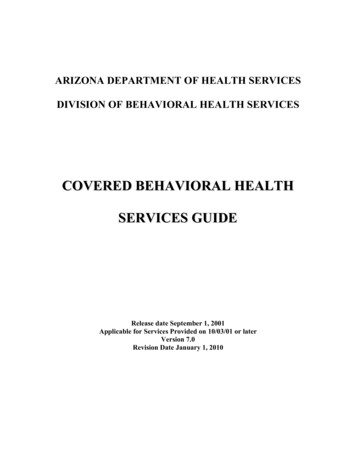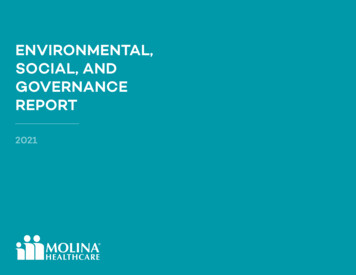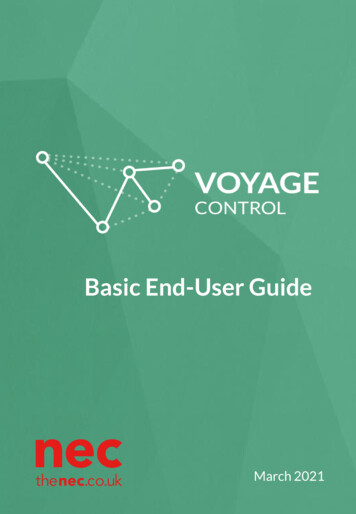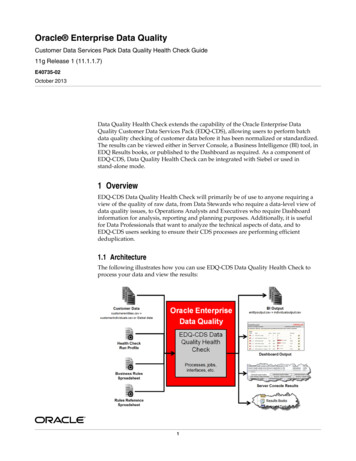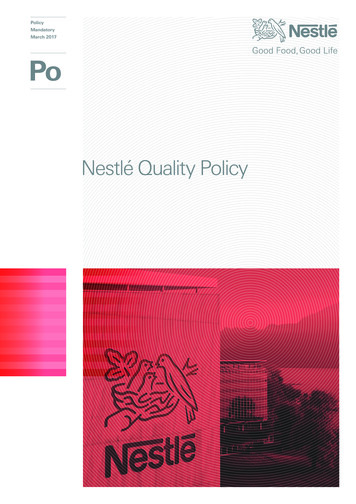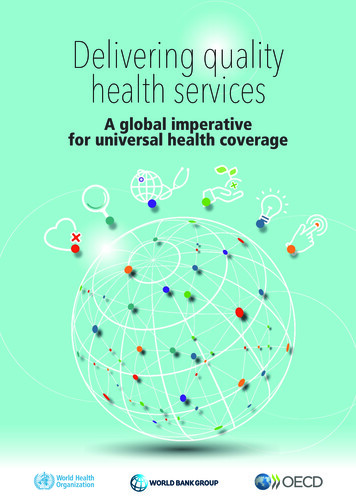
Transcription
Delivering qualityhealth servicesA global imperativefor universal health coverage
Delivering quality health services: a global imperative for universalhealth coverageISBN 978-92-4-151390-6 WHOISBN 978-92-64-30030-9 (PDF) OECD World Health Organization, OECD, andInternational Bank for Reconstruction and Development/The World Bank, 2018Some rights reserved. This work is available under the Creative Commons Attribution-NonCommercialShareAlike 3.0 IGO licence (CC BY-NC-SA 3.0 IGO; igo).Under the terms of this licence, you may copy, redistribute and adapt the work for non-commercial purposes,provided the work is appropriately cited, as indicated below. In any use of this work, there should be nosuggestion that WHO, OECD and The World Bank endorse any specific organization, products or services.The use of the WHO, OECD or The World Bank logo is not permitted. If you adapt the work, then you mustlicense your work under the same or equivalent Creative Commons licence and add the following disclaimeralong with the suggested citation: “This is an adaptation of an original work by WHO, OECD and The WorldBank. Responsibility for the views and opinions expressed in the adaptation rests solely with the author orauthors of the adaptation and are not endorsed by WHO, OECD or any member institution of the WorldBank Group”. If you create a translation of this work, you should add the following disclaimer along withthe suggested citation: “This translation was not created by the World Health Organization (WHO), OECDor The World Bank. WHO, OECD and The World Bank are not responsible for the content or accuracy of thistranslation. The original English edition shall be the binding and authentic edition”.Any mediation relating to disputes arising under the licence shall be conducted in accordance with themediation rules of the World Intellectual Property Organization sted citation. Delivering quality health services: a global imperative for universal health coverage.Geneva: World Health Organization, Organisation for Economic Co-operation and Development, and TheWorld Bank; 2018. Licence: CC BY-NC-SA 3.0 IGO.Cataloguing-in-Publication (CIP) data. CIP data are available at http://apps.who.int/iris.Sales, rights and licensing. To purchase WHO publications, see http://apps.who.int/bookorders. To submitrequests for commercial use and queries on rights and licensing, see http://www.who.int/about/licensing.Third-party materials. If you wish to reuse material from this work that is attributed to a third party, suchas tables, figures or images, it is your responsibility to determine whether permission is needed for that reuseand to obtain permission from the copyright holder. The risk of claims resulting from infringement of anythird-party-owned component in the work rests solely with the user.General disclaimers. The designations employed and the presentation of the material in this publicationdo not imply the expression of any opinion whatsoever on the part of the World Health Organization, OECDand The World Bank concerning the legal status of any country, territory, city or area or of its authorities,or concerning the delimitation of its frontiers or boundaries. Dotted lines on maps represent approximateborder lines for which there may not yet be full agreement.The mention of specific companies or of certain manufacturers’ products does not imply that they areendorsed or recommended by the World Health Organization, OECD and The World Bank in preference toothers of a similar nature that are not mentioned. Errors and omissions excepted, the names of proprietaryproducts are distinguished by initial capital letters.All reasonable precautions have been taken by the World Health Organization, OECD and The World Bankto verify the information contained in this publication. However, the published material is being distributedwithout warranty of any kind, either expressed or implied. The responsibility for the interpretation and useof the material lies with the reader. In no event shall the World Health Organization, OECD and The WorldBank be liable for damages arising from its use.The findings, interpretations and conclusions expressed in this publication do not necessarily reflect the viewsof WHO, OECD or The World Bank, its Board of Executive Directors, or the governments they represent.The World Bank does not guarantee the accuracy of the data included in this publication.Printed in SwitzerlandIcons designed by Freepik, from www.flaticon.com
ContentsPreface . . . . . . . . . . . . . . . . . . . . . . . . . . . . . . . . . . . . . . . . . . . . . . . . . . . . . . . . . . . . . . . . . . . . . . . . . . . . . . . . . . . . . . . . . . . . . . . . . 5Acknowledgements. . . . . . . . . . . . . . . . . . . . . . . . . . . . . . . . . . . . . . . . . . . . . . . . . . . . . . . . . . . . . . . . . . . . . . . . . . . . . . . . 7Abbreviations. . . . . . . . . . . . . . . . . . . . . . . . . . . . . . . . . . . . . . . . . . . . . . . . . . . . . . . . . . . . . . . . . . . . . . . . . . . . . . . . . . . . . . . . 9Executive summary . . . . . . . . . . . . . . . . . . . . . . . . . . . . . . . . . . . . . . . . . . . . . . . . . . . . . . . . . . . . . . . . . . . . . . . . . . . . . . 11Chapter 11.11.21.31.4Background: striving for quality in health care services. . . . . . . . . . . . . .Widespread evidence of poor quality in all countries. . . . . . . . . . . . . . . . . . . . . . . .The economic argument for good quality. . . . . . . . . . . . . . . . . . . . . . . . . . . . . . . . . . . . . .Quality as a fundamental feature of universal health coverage. . . . . . . . . . . .Affordability of quality for all countries. . . . . . . . . . . . . . . . . . . . . . . . . . . . . . . . . . . . . . . . .1516171719Chapter 22.12.22.3About this document . . . . . . . . . . . . . . . . . . . . . . . . . . . . . . . . . . . . . . . . . . . . . . . . . . . . . . . . . . . .Objectives . . . . . . . . . . . . . . . . . . . . . . . . . . . . . . . . . . . . . . . . . . . . . . . . . . . . . . . . . . . . . . . . . . . . . . . . . . . . .Scope. . . . . . . . . . . . . . . . . . . . . . . . . . . . . . . . . . . . . . . . . . . . . . . . . . . . . . . . . . . . . . . . . . . . . . . . . . . . . . . . . . .Content. . . . . . . . . . . . . . . . . . . . . . . . . . . . . . . . . . . . . . . . . . . . . . . . . . . . . . . . . . . . . . . . . . . . . . . . . . . . . . . .23242424Chapter 33.13.23.33.4Global state of health care quality . . . . . . . . . . . . . . . . . . . . . . . . . . . . . . . . . . . . . . . . . .The quality imperative for universal health coverage . . . . . . . . . . . . . . . . . . . . . . . .Defining quality of care . . . . . . . . . . . . . . . . . . . . . . . . . . . . . . . . . . . . . . . . . . . . . . . . . . . . . . . . . . . .Global picture of health care quality. . . . . . . . . . . . . . . . . . . . . . . . . . . . . . . . . . . . . . . . . . . . .Conclusion. . . . . . . . . . . . . . . . . . . . . . . . . . . . . . . . . . . . . . . . . . . . . . . . . . . . . . . . . . . . . . . . . . . . . . . . . . . .2728303237Chapter 44.14.24.34.44.5Building quality into the foundations of health systems . . . . . . . . . . . .Introduction. . . . . . . . . . . . . . . . . . . . . . . . . . . . . . . . . . . . . . . . . . . . . . . . . . . . . . . . . . . . . . . . . . . . . . . . . . .Foundations for high-quality care. . . . . . . . . . . . . . . . . . . . . . . . . . . . . . . . . . . . . . . . . . . . . . . .Quality of care as the foundation of people-centred health care. . . . . . . . . .The vision: health systems committed to people-centred care. . . . . . . . . . . . .Conclusion. . . . . . . . . . . . . . . . . . . . . . . . . . . . . . . . . . . . . . . . . . . . . . . . . . . . . . . . . . . . . . . . . . . . . . . . . . . .414242495254Chapter 55.15.25.35.45.5Understanding levers to improve quality . . . . . . . . . . . . . . . . . . . . . . . . . . . . . . . . .Introduction. . . . . . . . . . . . . . . . . . . . . . . . . . . . . . . . . . . . . . . . . . . . . . . . . . . . . . . . . . . . . . . . . . . . . . . . . . .Driving improvement through national quality policy and strategy. . . . . . .Quality interventions. . . . . . . . . . . . . . . . . . . . . . . . . . . . . . . . . . . . . . . . . . . . . . . . . . . . . . . . . . . . . . . .Consideration and selection of quality interventions. . . . . . . . . . . . . . . . . . . . . . . . .Conclusion. . . . . . . . . . . . . . . . . . . . . . . . . . . . . . . . . . . . . . . . . . . . . . . . . . . . . . . . . . . . . . . . . . . . . . . . . . . .575858626567Chapter 6 The quality call to action. . . . . . . . . . . . . . . . . . . . . . . . . . . . . . . . . . . . . . . . . . . . . . . . . . . . . . . . 736.1 Sustainable development, quality and the way forward. . . . . . . . . . . . . . . . . . . . 746.2 Call to action . . . . . . . . . . . . . . . . . . . . . . . . . . . . . . . . . . . . . . . . . . . . . . . . . . . . . . . . . . . . . . . . . . . . . . . . . 74References . . . . . . . . . . . . . . . . . . . . . . . . . . . . . . . . . . . . . . . . . . . . . . . . . . . . . . . . . . . . . . . . . . . . . . . . . . . . . . . . . . . . . . . . . . 77Annex:Improvement interventions. . . . . . . . . . . . . . . . . . . . . . . . . . . . . . . . . . . . . . . . . . . . . . . . . . . . 87DELIVERING QUALITY HEALTH SERVICES: A GLOBAL IMPERATIVE FOR UNIVERSAL HEALTH COVERAGE3
ContentsFiguresFigure 3.1 Median under-5 mortality across dimensions of inequality, 2005–2012. . . . . . . . . . . . . . . 28Figure 3.2 Elements of health care quality. . . . . . . . . . . . . . . . . . . . . . . . . . . . . . . . . . . . . . . . . . . . . . . . . . . . . . . . . . . . . 31Figure 3.3 Number of clinical vignettes correctly diagnosed by Kenyan providers . . . . . . . . . . . . . . . . 33Figure 3.4 Burden of disease caused by adverse events, 2015. . . . . . . . . . . . . . . . . . . . . . . . . . . . . . . . . . . . . . 34Figure 3.5 Doctor providing easy-to-understand explanations . . . . . . . . . . . . . . . . . . . . . . . . . . . . . . . . . . . . . . 35Figure 3.6 Trends in average waiting times for hip replacement. . . . . . . . . . . . . . . . . . . . . . . . . . . . . . . . . . . . 36Figure 3.7 Structural and process quality of maternal services by county poverty levelin Kenya . . . . . . . . . . . . . . . . . . . . . . . . . . . . . . . . . . . . . . . . . . . . . . . . . . . . . . . . . . . . . . . . . . . . . . . . . . . . . . . . . . . . . . 36Figure 4.1 Global density and distribution of skilled health professionals. . . . . . . . . . . . . . . . . . . . . . . . . . 43Figure 4.2 Variations in availability of basic equipment across health care facilitiesin sub-Saharan Africa . . . . . . . . . . . . . . . . . . . . . . . . . . . . . . . . . . . . . . . . . . . . . . . . . . . . . . . . . . . . . . . . . . . . . . . 45Figure 4.3 Primary care as a hub of coordination. . . . . . . . . . . . . . . . . . . . . . . . . . . . . . . . . . . . . . . . . . . . . . . . . . . . . 53Figure 4.4 Five strategies for people-centred services. . . . . . . . . . . . . . . . . . . . . . . . . . . . . . . . . . . . . . . . . . . . . . . . 54TablesTable 5.1 Illustrative quality interventions . . . . . . . . . . . . . . . . . . . . . . . . . . . . . . . . . . . . . . . . . . . . . . . . . . . . . . . . . . . . 66Table 5.2 Quality-related interventions: engaging key actors. . . . . . . . . . . . . . . . . . . . . . . . . . . . . . . . . . . . . . . 68BoxesBox 3.1Box 4.1Box 4.2Box 4.3Box 4.4Box 4.5Box 4.6Box 4.7Box 5.1Box 5.2Box 5.34Liberia: embedding quality in the post-Ebola health agenda . . . . . . . . . . . . . . . . . . . . . . . . . . . 30Case study: training and retaining health care workers in underserved areasof the Philippines . . . . . . . . . . . . . . . . . . . . . . . . . . . . . . . . . . . . . . . . . . . . . . . . . . . . . . . . . . . . . . . . . . . . . . . . . . . . 44Case study: OECD Health Care Quality Indicators Project. . . . . . . . . . . . . . . . . . . . . . . . . . . . . . . 47Case study: improving civil registration and vital statistics in Uganda. . . . . . . . . . . . . . . . . . 48Case study: unmet needs for the care of chronic diseases . . . . . . . . . . . . . . . . . . . . . . . . . . . . . . 50Case study: primary care in Costa Rica. . . . . . . . . . . . . . . . . . . . . . . . . . . . . . . . . . . . . . . . . . . . . . . . . . . . 51Case study: using Citizen Voice and Action to empower communities in Uganda. . . 51Key actions: building quality into the foundations of health systems. . . . . . . . . . . . . . . . . . 55Box 5.4Box 5.5Case study: Ethiopia – National Health Care Quality Strategy 2016–2020. . . . . . . . . . . . 59Case study: Sudan – National Health Care Quality Policy and Strategy. . . . . . . . . . . . . . . . 60Case study: Mexico – National Strategy for Quality Consolidation in Health CareFacilities and Services. . . . . . . . . . . . . . . . . . . . . . . . . . . . . . . . . . . . . . . . . . . . . . . . . . . . . . . . . . . . . . . . . . . . . . . . 61Case study: Ontario, Canada – Excellent Care for All Act and Strategy. . . . . . . . . . . . . . . . 64Key actions: understanding levers to improve quality. . . . . . . . . . . . . . . . . . . . . . . . . . . . . . . . . . . . 69Box 6.1High-level actions by key constituencies for quality in health care . . . . . . . . . . . . . . . . . . . . . 75
PrefaceThe Sustainable Development Goals (SDGs) reaffirm a global commitment to achieveuniversal health coverage (UHC) by 2030. This means that all people and communities,everywhere in the world, should have access to the high-quality health services theyneed – promotive, preventive, curative, rehabilitative, or palliative – without facingfinancial hardship.The way we typically measure progress in UHC is through effective coverage of essentialhealth services and financial protection (ensuring that no one becomes impoverishedbecause of ill-health). But even if the world achieved essential health coverage andfinancial protection, health outcomes would still be poor if services were low-qualityand unsafe. Delivering quality health services is essential to UHC. That is the focus ofthis report.Evidence suggests that substandard care wastes significant resources and harms thehealth of populations, destroying human capital and reducing productivity. Qualityof care, especially patient safety, is essential to creating trust in health services. It isalso key to global health security, which starts with local health security, and in turndepends on high-quality frontline health services. Quality health services not onlyprevent human suffering and ensure healthier societies, they also ensure better humancapital and healthier economies.Too often, quality is perceived as a luxury that only rich countries can afford. This is afallacy. Building quality health services requires a culture of transparency, engagement,and openness about results, which are possible in all societies – regardless of theirincome level. Around the world, lessons abound on what works and what doesnot, providing a rich foundation from which to rapidly scale up a quality revolution.Technological innovation plays a key role in offering new ways to expand high-qualityhealth care services more rapidly, and at an affordable cost.A focus on people-centredness has to be the core of quality. People and communitiesmust be engaged in the design, delivery, and ongoing assessment of health servicesto ensure they are built to meet local health needs – rather than those of donors,commercial or political interests, or because “it’s always been done that way”.Focusing on quality is critical, but leadership must also focus on celebrating excellence;communicating transparently; and fostering collaboration across clinical teams, aswell as with patients, and civil society – including patient groups, nongovernmentalorganizations, and grassroots community groups.Universal health coverage is not a dream for the future. It is already a reality in manycountries; however, without quality health services, it can remain an empty promise.This foundational report builds a strong technical and political case for investing inquality health services. The collective prize is a healthier, safer and fairer world.Tedros Adhanom GhebreyesusDirector-GeneralWorld Health OrganizationJim Yong KimPresidentThe World Bank GroupAngel GurríaSecretary-GeneralOECDDELIVERING QUALITY HEALTH SERVICES: A GLOBAL IMPERATIVE FOR UNIVERSAL HEALTH COVERAGE5
AcknowledgementsThis document was jointly prepared by the World Health Organization (WHO), theOrganisation for Economic Co-operation and Development (OECD) and the World Bankunder the overall guidance of Marie-Paule Kieny, former Assistant Director-General,Health Systems and Innovation Cluster, WHO; Timothy Evans, Senior Director, Health,Nutrition and Population Global Practice, World Bank Group; and Stefano Scarpetta,Director of Employment, Labour and Social Affairs, OECD. The writing team comprisedEdward Kelley (WHO), Niek Klazinga (OECD), Ian Forde (OECD), Jeremy Veillard(World Bank), Sheila Leatherman (Gillings School of Global Public Health, University ofNorth Carolina), Shamsuzzoha Syed (WHO), Sun Mean Kim (WHO), Sepideh BagheriNejad (WHO) and Sir Liam Donaldson (WHO Envoy for Patient Safety). Development ofthe document was coordinated by Sepideh Bagheri Nejad.The authors wish to thank colleagues from the Dutch National Institute for PublicHealth and the Environment (RIVM), Michael van den Berg and Wilco Graafmans fortheir input to the development of the overall conceptual framework and content of thedocument, Stefano Scarpetta, Mark Pearson, Francesca Colombo, Caroline Berchet andLuke Slawomirski from OECD for their contribution to the writing, and Sagar Duganiand Adanna Deborah Ugochi Chukwuma from the World Bank for their help with therevision of the text at the final stage.The document benefited from the rich inputs of the Advisory Committee, composedof the following members: Sir Liam Donaldson (Chair), Clifford Hughes, Tawfik Khoja,Jan Mainz, Rashad Massoud, Robin Osborn, Enrique Ruelas, Paul Shekelle, AnuwatSupachutikul and Nana Amma Twum-Danso.Country case studies were produced by the following people: Daniel Burssa andEyub Gebretsadik for Ethiopia; Sebastian García Saiso, Paulina Pacheco Estrello andEnrique Ruelas for Mexico; Elmuez Eltayeb for Sudan; and Michelle Rossi, Joshua Tepperand Adalsteinn Brown for Ontario, Canada.The annex on improvement interventions was produced by Sheila Leatherman (GillingsSchool of Global Public Health, University of North Carolina), and Liana RosenkrantzWoskie, Anthony Moccia, Ruma Rajbhandari and Kim Reimold (the Harvard Initiativeon Global Health Quality at the Harvard Global Health Institute).We wish to thank Gheorghe Sorin Banica and Laura Pearson for administrative supportand Gary Humphreys for writing the initial draft of the document.We would also like to thank the following peer reviewers: Donald Berwick, Helen Haskell,Margaret Kruk and Ephrem Lemango.Finally, we would like to express our appreciation to the many other staff membersfrom the three partner organizations who contributed to this document. Without theirdedication, support and expertise this work would not have been possible:Yetmgeta Abdella, Najeeb Al Shorbaji, Benedetta Allegranzi, Broog Alsadhan, ShannonBarkley, Marie-Charlotte Bouesseau, James Campbell, Meena Cherian, Mickey Chopra,Krycia Cowling, Jishnu Das, Neelam Dhingra-Kumar, Joan Dzenowagis, Peter Engelfriet,Linda Freiheit, Ruben Frescas, Michele Gragnolati, Michelle Karen Funk, Javier GomezBatiste‑Alentorn, Joyce Hightower, Maki Kajiwara, Rania Kawar, Michael George Kay,DELIVERING QUALITY HEALTH SERVICES: A GLOBAL IMPERATIVE FOR UNIVERSAL HEALTH COVERAGE7
AcknowledgementsClaire Kilpatrick, Ramesh Krishnamurthy, Angela Lashoher, Agnès Leotsakos,Manon Lette, Akiko Maeda, Nicola Magrini, Elizabeth Mason, Kellie McGee,Nana Mensah Abrampah, Hernan Montenegro Von Mühlenbrock, Margaret Murphy,Jillian Oderkirk, Shanti Pal, Felicity Pocklington, Nittita Prasopa-Plaizier, Paul PeterSchneider, Emma Scholar, Maria Cecilia Sepulveda Bermedo, Maria Angelica Sousa,Julie Storr, Nuria Toro Polanco, Andreas Ullrich, Krisantha Weerasuriya, Erica Wheeler,Tana Wuliji, Mohammad Taghi Yasamy, Junping Yu, Hongwen Zhao and Hao Zheng.8
AbbreviationsCAIScentres for integrated health care (centros de atención integral en salud)CDSclinical decision supportDALYdisability-adjusted life-yearEBAISintegrated health care basic teams (equipos básicos de atenciónintegral de salud)EuroHOPE European Health Care Outcomes, Performance and Efficiency (project)HTAhealth technology assessmentMDGMillennium Development GoalOECDOrganisation for Economic Co-operation and DevelopmentP4Ppay for performanceSDGSustainable Development GoalUNICEFUnited Nations Children’s FundUSAIDUnited States Agency for International DevelopmentWHOWorld Health OrganizationDELIVERING QUALITY HEALTH SERVICES: A GLOBAL IMPERATIVE FOR UNIVERSAL HEALTH COVERAGE9
Abbreviations10
Executive summaryThis document – Delivering quality health services: a global imperative for universalhealth coverage – describes the essential role of quality in the delivery of health careservices. As nations commit to achieving universal health coverage by 2030, there isa growing acknowledgement that optimal health care cannot be delivered by simplyensuring coexistence of infrastructure, medical supplies and health care providers.Improvement in health care delivery requires a deliberate focus on quality of healthservices, which involves providing effective, safe, people-centred care that is timely,equitable, integrated and efficient. Quality of care is the degree to which health servicesfor individuals and populations increase the likelihood of desired health outcomes andare consistent with current professional knowledge.Data show that quality of care in most countries, particularly low- and middle-incomecountries, is suboptimal, as revealed by the following examples. Adherence to clinical practice guidelines in eight low- and middle-incomecountries was below 50% in several instances, resulting in low-quality antenataland child care and deficient family planning. The Service Delivery Indicators initiative in seven low- and middle-incomecountries showed significant variation in provider absenteeism (14.3–44.3%),daily productivity (5.2–17.4 patients), diagnostic accuracy (34–72.2%), and,adherence to clinical guidelines (22–43.8%). A systematic review of 80 studies showed that suboptimal clinical practice iscommon in both private and public primary health care facilities in several lowand middle-income countries. Organisation for Economic Co-operation and Development (OECD) data fromhigh- and middle-income countries show that 19–53% of women aged 50–69years did not receive mammography screening, and that 27–73% of older adults(age 65 years and above) did not receive influenza vaccination.BETTER HEALTH OUTCOMES THROUGH IMPROVEMENT IN QUALITYHigh-quality health services involve the right care, at the right time, respondingto the service users’ needs and preferences, while minimizing harm and resourcewaste. Quality health care increases the likelihood of desired health outcomes andis consistent with seven measurable characteristics: effectiveness, safety, peoplecentredness, timeliness, equity, integration of care and efficiency. For instance, inPakistan, increasing first-contact accessibility to health care workers through theLady Health Worker Programme improved management of pneumonia and loweredneonatal mortality.BUILDING QUALITY MECHANISMS INTO THE FOUNDATIONSOF HEALTH CARE SYSTEMSThe five foundational elements critical to delivering quality health care services arehealth care workers; health care facilities; medicines, devices and other technologies;information systems; and financing. To ensure that quality is built into the foundationsDELIVERING QUALITY HEALTH SERVICES: A GLOBAL IMPERATIVE FOR UNIVERSAL HEALTH COVERAGE11
Executive summaryof systems, governments, policy-makers, health system leaders, patients and cliniciansshould work together to: ensure a high-quality health workforce;ensure excellence across all health care facilities;ensure safe and effective use of medicines, devices and other technologies;ensure effective use of health information systems;develop financing mechanisms that support continuous quality improvement.INTERVENTIONS TO IMPROVE QUALITY OF CAREQuality is a complex and multifaceted concept that requires the design and simultaneousdeployment of combinations of discrete interventions. The development, refinementand execution of a national quality policy and strategy is a growing priority as countriesstrive to systematically improve health system performance. Most approaches tonational quality strategy development involve one or more of the following processes: a quality policy and implementation strategy as part of the formal health sectornational plan; a quality policy document developed as a stand-alone national document, usuallywithin a multistakeholder process, led or supported by the ministry of health; a national quality implementation strategy – with a detailed action agenda –which also includes a section on essential policy areas; enabling legislation and regulatory statutes to support the policy and strategy.Seven categories of interventions stand out and are routinely considered by healthsystem stakeholders, including providers, managers and policy-makers, when trying toimprove the quality of the health care system: changing clinical practice at the front line;setting standards;engaging and empowering patients, families and communities;information and education for health care workers, managers and policy-makers;use of continuous quality improvement programmes and methods;establishing performance-based incentives (financial and non-financial);legislation and regulation.Selection by governments of a range and mix of quality interventions should be doneby carefully examining the evidence-based quality improvement interventions inrelation to the system environment; reducing harm; improvement in clinical care; andpatient, family and community engagement and empowerment.SHARING OF LESSONS LEARNED FOR SCALE-UP OF SUCCESSFULINTERVENTIONSSeveral nations are developing innovations to improve the different aspects of quality.As described in this document, many low- and middle-income countries have developedsuccessful interventions, but require a global platform to share knowledge. This willallow nations to learn from successful interventions and adapt them to their localpopulations. It will also allow nations to avoid directing efforts towards unsuccessfulinterventions.12
Improving quality of care has proven challenging for all nations. However, providingquality care to people everywhere remains the most important shared responsibilityand opportunity to improve the health of people globally. With a deliberate emphasison quality, nations will be able to make significant progress towards achieving theSustainable Development Goals and attaining universal health coverage.CALL TO ACTIONThis document, from the perspective of three global institutions concerned withhealth – OECD, the World Bank and the World Health Organization – proposes a wayforward for health policy-makers seeking to achieve the goal of access to high-quality,people-centred health services for all.High-level actions are called for from each of the key constituencies that need towork together with a sense of urgency to enable the promise of the SustainableDevelopment Goals for better and safer health care to be realized.All governments should: have a national quality policy and strategy; ensure that health systems have an infrastructure of information and informationtechnology capable of measuring and reporting the quality of care; close the gap between actual and achievable performance in quality; establish and sustain a health professional workforce with the capacity andcapability to meet the demands and needs of the population for high-quality care; purchase, fund and commission based on the principle of value;demonstrate accountability for delivering a safe high-quality service;ensure that reforms driven by the goal of universal health coverage build qualityinto the foundation of their care systems;strengthen the partnerships between health providers and health users that drivequality in care;finance quality improvement research.All health systems should: implement evidence-based interventions that demonstrate improvement; promote the culture systems and practices that will reduce harm to patients; put in place the infrastructure for learning;benchmark against similar systems that are delivering best performance;ensure that all people with chronic disease are enabled to minimize its impact onthe quality of their lives;build resilience to enable prevention, detection and response to health securitythreats through focused attention on quality;provide technical assistance and knowledge management for improvement.All citizens and patients should: be empowered to actively engage in care to optimize their health status; be informed that it is their right to have access to care that meets achievablemodern standards of quality; receive support, information and skills to manage their own long-term conditions.play a leading role in the design of new models of care to meet the needs of thelocal community;DELIVERING QUALITY HEALTH SERVICES: A GLOBAL IMPERATIVE FOR UNIVERSAL HEALTH COVERAGE13
Executive summaryAll health care workers should: participate in quality measur
health services and financial protection (ensuring that no one becomes impoverished because of ill-health). But even if the world achieved essential health coverage and financial protection, health outcomes would still be poor if services were low-quality and unsafe. Delivering quality health services is essential to UHC. That is the focus of
